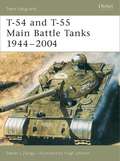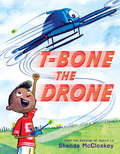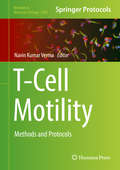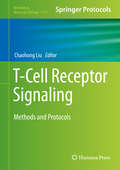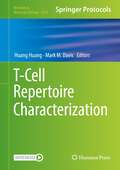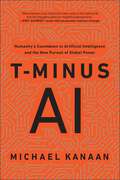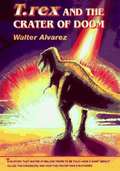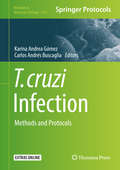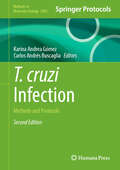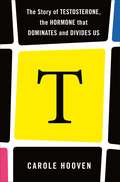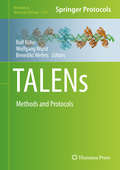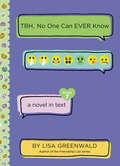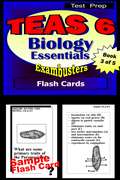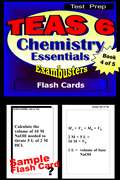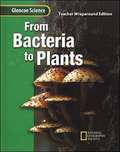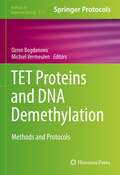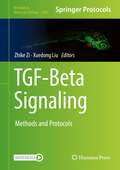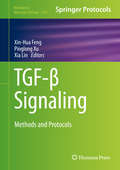- Table View
- List View
T-34 in Action: Soviet Tank Troops In World War Ii (Stackpole Military History Ser.)
by Artem Drabkin Oleg SheremetFirst-hand accounts from the Russian veterans of World War II who fought in the celebrated tanks that powered the Soviet armored forces. The Soviet T-34 medium tank was one of the most famous and effective fighting vehicles of the Second World War. Along with the German Tiger and the American Sherman, it was a milestone in tank design that changed the course of the conflict. Much has been written about the technical history of the tank and the vital part it played in the huge tank battles on the Eastern Front, but less has been said about the men who went to war in the T-34 and lived, fought and sometimes died in these remarkable machines. This pioneering book, which is based on extensive interviews with tank crews, records their experiences and offers a compelling inside view of armored warfare in the mid-twentieth century. &“An engaging book, and you will find yourself feeling the discomfort, anxiety, fear, pride and joy of a Soviet Tanker in WWII as you read the T-34 in Action.&”—Military Trader &“An excellent read and a good book for tank enthusiasts.&”—The Armourer
T-54 and T-55 Main Battle Tanks, 1944-2004
by Steven J. ZalogaThe T-54 and T-55 tanks are the most widely manufactured tanks of all time. They have become ubiquitous to wars around the globe since the 1950s, starting with Hungary in 1956, and including the the Arab-Israeli wars of 1967, 1973 and 1982, the Vietnam war of 1967-75, the Iran-Iraq War of 1980-88, the Afghanistan conflict, Operation Desert Storm, the Yugoslav Civil Wars, and the recent conflict in Iraq. This book will examine the roots of this prolific tank family, starting with the Soviet Army's first attempts to replace the legendary T-34 during World War II, and covering the T-43 and the T-44, the more successful T-54, and its ultimate evolution into the T-55.
T-Bone the Drone
by Shanda McCloskeyA new tech toy brings epic trials and triumphs in this playtime adventure for fans of The Most Magnificent Thing and Iggy Peck, Architect.Lucas has a new best friend when he bring T-Bone the Drone home from the store. They enjoy playing, flying, and even recharging together--but Lucas has been spending so much time with his new toy that he's on the sidelines when he tries to join the neighborhood Wiffle ball game. When the ball sails over the fence where a scary dog lives, it's the perfect opportunity for Lucas and T-Bone to do what friends do best: work together! It turns out that they'll need help from the whole team, though, to save the day...Finding the solution takes a little ingenuity and a lot of teamwork in this companion story to Doll-E 1.0 celebrating the inventive spirit of modern play.
T-Cell Motility: Methods and Protocols (Methods in Molecular Biology #1930)
by Navin Kumar VermaThis volume discusses the latest developments in cellular, molecular, biochemical, and imaging assays to study the biology and functions of T-cells. The chapters in this book cover topics such as LFA-1/ICAM-1 interactions in T-cell motility; using 3D-SIM to dissect signaling cross-talks in motile T-cells; GapmeR-mediated gene silencing in motile T-cells; activity of cellular kinases in migrating T-cells; and computational analysis of protein-protein interactions in motile T-cells. Written in the highly successful Methods in Molecular Biology series format, chapters include introductions to their respective topics, lists of the necessary materials and reagents, step-by-step, readily reproducible laboratory protocols, and tips on troubleshooting and avoiding known pitfalls.Cutting-edge and comprehensive, T-Cell Motility: Methods and Protocols is an essential resource for graduate students, postdoctoral fellows, and principal investigators working in the fields of immunology, T-cell biology, biochemistry, molecular biology, and imaging.
T-Cell Receptor Signaling: Methods and Protocols (Methods in Molecular Biology #2111)
by Chaohong LiuThis volume provides current and new advanced methods and protocols to study T cells. Chapters guide readers through T cell diversity using mass cytometry, analyzing T cells from single cell level, CRISPR/Cas9 techniques to study the T cell activation, techniques to study subsets of Tcell’s, procedures to study artificial antigen presentosomes for T cell activation, techniques to study the T cell development, two-photon microscopy, and MAIT cells. Written in the highly successful Methods in Molecular Biology series format, chapters include introductions to their respective topics, lists of the necessary materials and reagents, step-by-step, readily reproducible laboratory protocols, and tips on troubleshooting and avoiding known pitfalls. Authoritative and cutting-edge, T-Cell Receptor Signaling: Methods and Protocols aims to provide a wide range of approaches and be an invaluable resource for present and future generations of T cell researchers.
T-Cell Repertoire Characterization (Methods in Molecular Biology #2574)
by Mark M. Davis Huang HuangThis volume provides a comprehensive compilation of protocols in T cell repertoire analysis, from the leading experts in the field, representing both well-established methods and cutting-edge advances. Chapters broadly cover the emerging new T cell subsets, sequencing technologies for capturing TCR repertoire, and computational tools for analyzing an ever-growing TCR repertoire, with a particular focus on how to link the sequence with TCR antigen specificity. Written in the successful Methods in Molecular Biology series format, chapters include introductions to their respective topics, lists of the necessary materials and reagents, step-by-step, readily reproducible protocols, and notes on troubleshooting and avoiding known pitfalls. Authoritative and cutting-edge, T-Cell Repertoire Characterization aims to be a useful practical guide to researches to help further their study in this field.
T-Minus AI: Humanity's Countdown to Artificial Intelligence and the New Pursuit of Global Power
by Michael KanaanLate in 2017, the global significance of the conversation about artificial intelligence (AI) changed forever. China put the world on alert when it released a plan to dominate all aspects of AI across the planet. Only weeks later, Vladimir Putin raised a Russian red flag in response by declaring AI the future for all humankind, and proclaiming that, "Whoever becomes the leader in this sphere will become the ruler of the world." The race was on. Consistent with their unique national agendas, countries throughout the world began plotting their paths and hurrying their pace. Now, not long after, the race has become a sprint. Despite everything at stake, to most of us AI remains shrouded by a cloud of mystery and misunderstanding. Hidden behind complicated and technical jargon and confused by fantastical depictions of science fiction, the modern realities of AI and its profound implications are hard to decipher, but crucial to recognize. In T-Minus AI: Humanity's Countdown to Artificial Intelligence and the New Pursuit of Global Power, author Michael Kanaan explains AI from a human-oriented perspective we can all finally understand. A recognized national expert and the U.S. Air Force's first Chairperson for Artificial Intelligence, Kanaan weaves a compelling new view on our history of innovation and technology to masterfully explain what each of us should know about modern computing, AI, and machine learning. Kanaan also dives into the global implications of AI by illuminating the cultural and national vulnerabilities already exposed and the pressing issues now squarely on the table. AI has already become China's all-purpose tool to impose its authoritarian influence around the world. Russia, playing catch up, is weaponizing AI through its military systems and now infamous, aggressive efforts to disrupt democracy by whatever disinformation means possible. America and like-minded nations are awakening to these new realities—and the paths they're electing to follow echo loudly the political foundations and, in most cases, the moral imperatives upon which they were formed. As we march toward a future far different than ever imagined, T-Minus AI is fascinating and crucially well-timed. It leaves the fiction behind, paints the alarming implications of AI for what they actually are, and calls for unified action to protect fundamental human rights and dignities for all.
T. Rex and the Crater of Doom
by Walter AlvarezA geologist describes his research into the extinction of Tyrannosaurus rex and all dinosaurs, caused by a comet or asteroid hitting the Earth.
T. cruzi Infection: Methods and Protocols (Methods in Molecular Biology #1955)
by Karina Andrea Gómez Carlos Andrés BuscagliaThis volume provides detailed descriptions on cutting-edge experimental methods to assess the multiple and complex interactions between T. cruzi and its host. Chapters detail a series of methods and protocols, ranging from rather classical biochemical/genetic approaches to modern, powerful and high-throughput ‘-omics’ technologies, to tackle this issue, as well as novel techniques to improve treatment and clinical evaluation of Chagasic patients. Genome-wide mining strategies aimed at identifying potential parasite antigens and vaccine candidates and an overview on the challenges and milestones encountered during T. cruzi genome assembly are also included. Written in the highly successful Methods in Molecular Biology series format, chapters include introductions to their respective topics, lists of the necessary materials and reagents, step-by-step, readily reproducible laboratory protocols, and tips on troubleshooting and avoiding known pitfalls.Authoritative and cutting-edge, T. cruzi Infection: Methods and Protocols aims to provide students, researchers, and clinicians who are interested in the study of Chagas disease an indispensable source of information.
T. cruzi Infection: Methods and Protocols (Methods in Molecular Biology #2982)
by Karina Andrea Gómez Carlos Andrés BuscagliaThis fully updated volume explores experimental methods to assess the complex interactions between Trypanosoma cruzi and its host and to study different aspects of T. cruzi and Chagas disease. The techniques presented, which touch on areas of bioinformatics, biochemistry, genetics, and cell biology research, have been recently developed or adapted to the T. cruzi system by leading experts in the field. Written for the highly successful Methods in Molecular Biology series, chapters include introductions to their respective topics, lists of the necessary materials and reagents, step-by-step and readily reproducible laboratory protocols, and tips for troubleshooting and avoiding known pitfalls. Authoritative and practical, T. cruzi Infection: Methods and Protocols, Second Edition provides a comprehensive understanding of the basic biology of this parasite and its crosstalk with the host immune response that aims to inspire further understanding of Chagas disease epidemiology, diagnosis, treatment, and clinical evaluation.
T: The Story of Testosterone, the Hormone that Dominates and Divides Us
by Carole HoovenThrough riveting personal stories and the latest research, Harvard evolutionary biologist Carole Hooven shows how testosterone drives the behavior of the sexes apart and how understanding the science behind this hormone is empowering for all.Since antiquity—from the eunuchs in the royal courts of ancient China to the booming market for “elixirs of youth” in nineteenth-century Europe—humans have understood that typically masculine behavior depends on testicles, the main source of testosterone in males. Which sex has the highest rates of physical violence, hunger for status, and desire for a high number of sex partners? Just follow the testosterone.Although we humans can study and reflect on our own behavior, we are also animals, the products of millions of years of evolution. Fascinating research on creatures from chimpanzees to spiny lizards shows how high testosterone helps males out-reproduce their competitors. And men are no exception.While most people agree that sex differences in human behavior exist, they disagree about the reasons. But the science is clear: testosterone is a potent force in human society, driving the bodies and behavior of the sexes apart. But, as Hooven shows in T, it does so in concert with genes and culture to produce a vast variety of male and female behavior. And, crucially, the fact that many sex differences are grounded in biology provides no support for restrictive gender norms or patriarchal values. In understanding testosterone, we better understand ourselves and one another—and how we might build a fairer, safer society.
TALENs
by Ralf Kühn Wolfgang Wurst Benedikt WefersThis volume provides a comprehensive collection of protocols on new technology across various model organisms. Chapters describe species-specific methods to generate new mutants the content is completed by chapters on natural TAL effectors, TAL element DNA binding principles, TALEN target site prediction, and methods for the efficient construction of TALEN coding regions. While addition chapter focus on the application of TALEN as sequence-specific nucleases and TAL based gene activators or inhibitors and the visualization of chromatin dynamics in live cells. Written in the highly successful Methods in Molecular Biology series format, chapters include introductions to their respective topics, lists of the necessary materials and reagents, step-by-step, readily reproducible laboratory protocols, and tips on troubleshooting and avoiding known pitfalls. Authoritative and cutting-edge, TALENs: Methods and Protocols aims to ensure successful results in the further study of this vital field.
TBH #5: TBH, I Feel the Same (TBH #5)
by Lisa GreenwaldThree BFFs try to make new friends but keep the old in the fifth book in Lisa Greenwald’s hilarious series told entirely in text messages, emojis, and notes. Perfect for fans of Invisible Emmie and the Dork Diaries books.Making new friends is a good thing, right? Not when you barely see your besties! Between swim team, the school play, and poetry club, BFFs Cece, Gabby, and Prianka are meeting different people and trying different things. But besties clash when Gabby’s new friends rank the other girls in their grade in categories like looks, smarts, and popularity.The question is: How can you be your best self if your BFFs don’t have your back?
TBH #6: TBH, You Know What I Mean (TBH #6)
by Lisa GreenwaldThree BFFs prove that girls can do anything they set their minds to in the sixth book in this hilarious series told entirely in text messages, emojis, and passed notes. Perfect for fans of Invisible Emmie and the Dork Diaries. TBH, sometimes boys say dumb things about girls. And Cece is sick of it!When she leads a super-successful event at school to raise awareness, everyone starts looking to her to take charge—of everything. Prianka needs ideas for National Poetry Month, Victoria wants advice on volunteer projects, and Gabby needs homework help. To be honest, being a leader is fun but the pressure is OOC (out of control)! Can Cece help her friends without totally losing it herself?
TBH #7: TBH, No One Can EVER Know (TBH #7)
by Lisa GreenwaldWith a Valentine’s Day dance, snooping parents, and way too many secrets, these four BFFs have a lot to deal with in the seventh book in this hilarious series told entirely in text messages, emojis, and passed notes, perfect for fans of Invisible Emmie and the Dork Diaries series. It’s no secret that Victoria’s mom can be OTT overprotective! But lately her anxiety has been too much to handle. So even though Victoria is helping plan the school’s Valentine’s Day dance, she might not be allowed to go!To be honest, she’s going to need lots of help from her BFFs to mend this mother-daughter relationship—and it may mean sharing her most embarrassing secret ever! The question is: Can you take back a secret once you’ve shared it?
TBH #8: TBH, I Don't Want to Say Good-bye (TBH #8)
by Lisa GreenwaldWhen summer break brings BIG changes, these BFFs 4EVA may end up saying good-bye 4EVA in the eighth and final book in this popular middle-grade series told entirely in text messages, emojis, and passed notes. Perfect for fans of Invisible Emmie and the Dork Diaries. TBH, Cece, Prianka, and Gabby thought they’d be together forever. But when Gabby’s mom announces she’s moving to Texas and a backyard BBQ party gets the friends’ blow-out summer off to a rocky start, they end up spending more time apart than together! To be honest, Gabby just wants to get the good-byes over with already. The question is: How can they be BFF 4EVA if everyone goes their separate ways?
TBH, This Is So Awkward (TBH #1)
by Lisa GreenwaldTold entirely in text messages, this addictive new series from the acclaimed author of My Life in Pink & Green is perfect for fans of Lauren Myracle and Wendy Mass. To be honest, middle school is rough! Cecily, Gabby, and Prianka have been BFFAE since pre-K, so it’s totally natural when they don’t include the new girl, Victoria, in their plans and group texts.Between organizing the school Valentine’s Day dance, prepping for their first boy-girl party, and trying to keep their texts so boring their moms won’t use spy apps to read them, the friends only have time for each other.But when Victoria is accidentally sent a hurtful text message, the entire sixth grade gets called out for bullying, cell phones are confiscated, and the trio known as CPG4Eva is forced to figure out just how strong their friendships are IRL.
TEAS 6 Test Prep Flash Cards: Biology Essentials (Exambusters TEAS 6 Workbook #3 of 5)
by Ace Inc.<P><P><i>Advisory: Bookshare has learned that this book offers only partial accessibility. We have kept it in the collection because it is useful for some of our members. Benetech is actively working on projects to improve accessibility issues such as these.</i><P><P> 450 questions and answers. Essential definitions and concepts. <P><P>Topics: Cells, Biochemistry and Energy, Evolution and Classification, Kingdoms: Bacteria, Fungi, Protista; Kingdom: Plantae, Kingdom: Animalia, Human Locomotion, Human Circulation and Immunology, Human Respiration and Excretion, Human Digestion, Human Nervous System, Human Endocrinology, Reproduction and Development, Genetics, Ecology <P>Exambusters TEAS 6 Prep Workbooks provide comprehensive, fundamental TEAS V review--one fact at a time--to prepare students to take practice TEAS V tests. Each TEAS V study guide focuses on one specific subject area covered on the TEAS V exams. From 300 to 600 questions and answers, each volume in the TEAS V series is a quick and easy, focused read. Reviewing TEAS V flash cards is the first step toward more confident TEAS V preparation and ultimately, higher TEAS V exam scores!
TEAS 6 Test Prep Flash Cards: Chemistry Essentials (Exambusters TEAS 6 Workbook #4 of 5)
by Ace Inc.<P><P><i>Advisory: Bookshare has learned that this book offers only partial accessibility. We have kept it in the collection because it is useful for some of our members. Benetech is actively working on projects to improve accessibility issues such as these.</i><P><P> 700 questions and answers. Essential definitions, formulas, concepts, and sample problems. <P><P>Topics: Introduction, Matter, Atoms, Formulas, Moles, Reactions, Elements, Periodic Table, Electrons, Chemical Bonds, Heat, Gases, Phase Changes, Solutions, Reaction Rates, Equilibrium, Acids and Bases, Oxidation and Reduction, Introduction to Organic Chemistry, Radioactivity <P>Exambusters TEAS 6 Prep Workbooks provide comprehensive, fundamental TEAS V review--one fact at a time--to prepare students to take practice TEAS V tests. Each TEAS V study guide focuses on one specific subject area covered on the TEAS V exams. From 300 to 600 questions and answers, each volume in the TEAS V series is a quick and easy, focused read. Reviewing TEAS V flash cards is the first step toward more confident TEAS V preparation and ultimately, higher TEAS V exam scores!
TET Proteins and DNA Demethylation: Methods and Protocols (Methods in Molecular Biology #2272)
by Ozren Bogdanovic Michiel VermeulenThis volume explores the latest methods used to study various aspects of TET proteins and their biology. Chapters in this book are divided into five parts. Part One describes technologies aimed at detecting and quantifying DNA methylation turnover using massively parallel sequencing, ELISA, and mass spectrometry approaches. Part Two looks at data analyses protocols for distinguishing acting versus passive DNA demethylation and estimation of 5mC and 5hmC levels. Part Three deals with a new topic that takes advantage of modified CRISPR/Cas9 genome editing systems to target DNA demethylation activity to genomic loci of interest. Part Four discusses protocols that detail how to purify TET proteins and unravel their protein interactions, and Part Five looks at the assessment of TET protein function and activity in vivo and in vitro. Written in the highly successful Methods in Molecular Biology series format, chapters include introductions to their respective topics, lists of the necessary materials and reagents, step-by-step, readily reproducible laboratory protocols, and tips on troubleshooting and avoiding known pitfalls. Cutting-edge and thorough, TET Proteins and DNA Demethylation: Methods and Protocols is a valuable resource that aims to help research scientists at all levels working in the fields of DNA demethylation dynamics.Chapters 3, 7 and 17 are available open access under a Creative Commons Attribution 4.0 International License via link.springer.com.
TGAU Gwyddoniaeth Gymhwysol CBAC: Single and Double Award
by Jeremy Pollard Adrian Schmit Sam HolymanDevelop students' understanding of Applied Science with engaging content and support throughout the course, produced by a trusted author team and an established WJEC GCSE Science publisher.Students will be able to:- learn what they need to know, with content clearly signposted to support the WJEC GCSE Applied Science Single Award and Double Award qualifications, at both lower and higher tier - approach exams with confidence, by checking their understanding with Test yourself questions, Discussion points, exam-style questions and useful Chapter summaries- build their practical skills with support for all specified practicals along with extra tasks for broader learning- develop the core mathematical skills required by the course with worked examples throughout the book.
TGAU Gwyddoniaeth Gymhwysol CBAC: Single and Double Award
by Jeremy Pollard Adrian Schmit Sam HolymanDevelop students' understanding of Applied Science with engaging content and support throughout the course, produced by a trusted author team and an established WJEC GCSE Science publisher.Students will be able to:- learn what they need to know, with content clearly signposted to support the WJEC GCSE Applied Science Single Award and Double Award qualifications, at both lower and higher tier - approach exams with confidence, by checking their understanding with Test yourself questions, Discussion points, exam-style questions and useful Chapter summaries- build their practical skills with support for all specified practicals along with extra tasks for broader learning- develop the core mathematical skills required by the course with worked examples throughout the book.
TGF-Beta Signaling: Methods and Protocols (Methods in Molecular Biology #2488)
by Xuedong Liu Zhike ZiThis detailed volume is devoted to the recent development of quantitative experiments and computational methods driving new transforming growth factor beta (TGF-β) and other cell signaling knowledge. Many chapters cover quantitative assays for TGF-β signaling studies, with others exploring the increasing role of both modeling and computational methods. Written for the highly successful Methods in Molecular Biology series, chapters include introductions to their respective topics, lists of the necessary materials and reagents, step-by-step, readily reproducible laboratory protocols, and tips on troubleshooting and avoiding known pitfalls. Authoritative and up-to-date, TGF-Beta Signaling: Methods and Protocols serves as a vital resource for researchers seeking to move the TGF-β field into the quantitative realm.
TGF-β Signaling
by Xin-Hua Feng Pinglong Xu Xia LinThis volume details up-to-date information and attempts to take the reader into the exciting realm of TGF-β from the basic principles to the practical applications. Chapters provide basic introduction of TGF-β signaling from the cell surface to the nucleus, methods and techniques for the investigation of TGF-β signaling mechanism including receptors, Smads, intracellular kinases, microRNA, epigenetic regulation, post-translational regulations, non-Smad pathway; the physiological implications including those in cell cycle arrest, epithelial-mesenchymal transition, endothelial cells, adipogenesis, Th differentiation, stem cell, bone remodeling, ovary, zebrofish development, and frog animal capping; and the methodologies including metastasis imaging, 3D morphogenesis, membrane receptor quantification, conditional knockout, bone remodeling, kinase and phosphatase assays, BiFC interaction assays, and genome-wide siRNA screen. Written in the highly successful Methods in Molecular Biology series format, chapters include introductions to their respective topics, lists of the necessary materials and reagents, step-by-step, readily reproducible laboratory protocols, and key tips on troubleshooting and avoiding known pitfalls. Authoritative and practical, TGF-Beta Signaling: Methods and Protocols aims to ensure successful results in the further study of this vital field.

